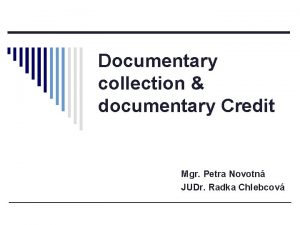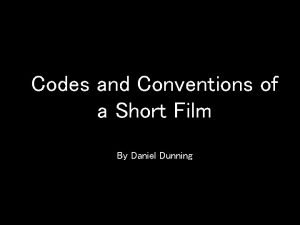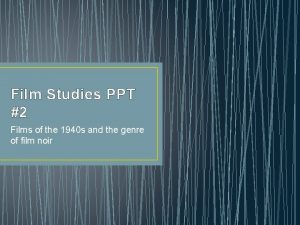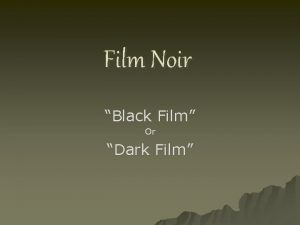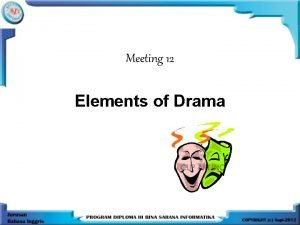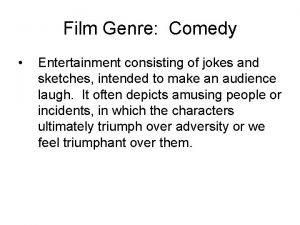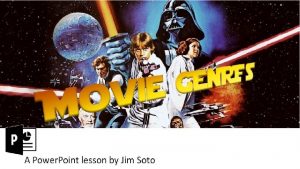Genre Film TV Genres Film DramaComedy Documentary ActionThriller
















- Slides: 16

Genre

Film & TV Genres • • • Film Drama/Comedy Documentary Action/Thriller Sci Fi Horror Musical Western Sword and Sandals Romantic Comedy Chick Flick High School Comedy • • • TV Animated Comedy Drama Soap Police Procedural Detective & Mystery Variety Kids/children Courtroom drama

• Film: fiction vs non fiction • TV : scripted vs non scripted • Non scripted: sporting events, game shows, reality shows and news. However, unless they are broadcast live, these "unscripted" TV shows are manipulated and edited to fit a particular running time and a predetermined outcome.

• Setting: Western, Period, Historical, Courtroom Thriller, WWII Picture • Theme: Disease of the Week, Romance, Alien Invasion • Mood: Horror, Film Noir, Comedy, Tearjerker • Format: 3 D, animation, cinemascope, Found footage • Audience: Melodrama, Teen movies, Chick flicks, Family film

• Generally, the action genres—adventure, war, gangster, detective, horror, science fiction, and of course, the western—were addressed to a male audience, while musicals and romantic melodramas (also known as ‘‘weepies’’) were marketed as ‘‘woman’s films. ’’

In film, common generic elements include • subject matter, • theme, • narrative • stylistic conventions, • character types, • plots, • and iconography.

Ways to identify a Genre 1. Narrative structures: • Types of plots • Plot situations and issues • Characters and character relationships

2. Visual Iconography • Props or costumes and signifiers • Shots and camera movements • Locations and backdrops • Lighting, styles, themes and background music • Mood and tone

Iconography • It refers to the signs that we associate with particular genres, such as physical attributes and dress of the actors, the settings and the ‘tools of the trade’ (cars, horses, guns). • It constitutes a pattern of visual imagery that remains common to a genre over a period of time.

3. Ideology and Themes: • Representations of gender, race, sexuality and place • Values and ideologies • Themes

The Function of Genre • The concept of genre is useful in looking at the ways in which media texts are organized, categorized and consumed. • The concept of genre suggests that there are certain types of media material, that are recognized through common elements, such as style, narrative and structure.

Genre and Audiences • Audiences are said to like the concept of genre because of its reassuring and familiar promise of patterns of repetition and variation. • Audiences become familiar with the codes and conventions of specific genres. Familiarity through repetition is therefore one of the key elements in the way audiences understand relate to media texts.

Limitations of Genre 1. The concept of genre clearly can have limitations when applied to a range of media texts because of the variety and the need for constant updating of texts that are being produced. Many texts may look similar but are too different to be grouped together

2. Sometimes the category becomes too generalized to be helpful. Consider the distinction between American fantasy soaps and British realism soap operas.

• Filmmakers from around the world have responded to the domination of American film by adopting Hollywood genres and ‘‘indigenizing’’ or reworking them according to their own cultural sensibility. Examples are the Italian ‘‘spaghetti western’’ or Hong Kong martial arts films. Other national cinemas have created their own genres. For example, German cinema in the 1920 s and 1930 s developed a distinctive genre of the mountain film, involving a character or group of characters striving to climb or conquer a mountain. The Heimatfilm, or Homeland film, is another genre of sentimental, romanticized movies about rural Germany and its inhabitants.

• In Indian cinema, masala (or mixed spice) films combine a variety of heterogenous generic elements, as by inserting musical sequences in a dramatic film in a way uncharacteristic of Hollywood. • In turn, Hollywood genre filmmaking has been influenced by some of these non. American genres. For example, Japanese samurai films
 D/a 30 days after sight
D/a 30 days after sight Documentary collection vs documentary credit
Documentary collection vs documentary credit Film genre meaning
Film genre meaning Film genres and definitions
Film genres and definitions Codes and conventions of short films
Codes and conventions of short films Ppt
Ppt Conventions of documentary
Conventions of documentary Characteristics of documentary
Characteristics of documentary Dark film genre
Dark film genre Blackswan genre
Blackswan genre Bij dit filmgenre klassieke oudheid
Bij dit filmgenre klassieke oudheid Teen film genre
Teen film genre Elements of a play
Elements of a play Teen movies genre
Teen movies genre Black comedy examples
Black comedy examples Genre film
Genre film Stranger things genre apa
Stranger things genre apa

